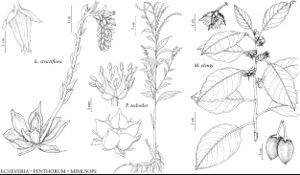Mimusops
Sp. Pl. 1: 349. 1753.
Gen. Pl. ed. 5, 165. 1754 ,.
Trees [shrubs]. Stems not armed, glabrate or hairy. Leaves persistent, alternate; stipules caducous; petiole present; blade: base rounded, cuneate, or attenuate, apex rounded, retuse, acute, or acuminate to cuspidate, surfaces glabrous or glabrate [hairy] abaxially, usually glabrous adaxially. Inflorescences fascicles or solitary flowers. Flowers: sepals 8 in 2 whorls of 4, outer valvate, larger, inner imbricate, [glabrate] densely hairy abaxially; petals (7–)8, white to yellow or pink, glabrous or hairy, lobes longer than corolla tube, each divided into 1 median and 2 lateral segments, median segment equaling or longer than laterals; stamens (7–)8, distinct distal to corolla tube; staminodes (7–)8, alternating with stamens, inflexed, petaloid, lanceolate, hairy; pistil (7–)8-carpellate; ovary (7–)8-locular, hairy; placentation basal or basiventral. Berries yellow to orange, subglobose, [glabrous] glabrate. Seeds 1[–6], [buff] brown to black, laterally compressed; hilum circular [elliptic]; embryo vertical; endosperm present. x = 12.
Distribution
Introduced; Fla., Asia, Africa, Indian Ocean Islands, Pacific Islands.
Discussion
Species ca. 30 (1 in the flora).
Mimusops is not native in the New World. Three species are cultivated commonly in the Neotropics: M. balata C. F. Gaertner, M. coriacea (A. de Candolle) Miquel and M. elengi. Mimusops elengi is naturalized and described here, whereas M. balata and M. coriacea apparently are becoming naturalized in southern Florida. American and West Indian species formerly placed in Mimusops are now included in Manilkara (T. D. Pennington 1990, 1991). Mimusops is characterized by elliptic or circular seed scars and eight-merous flowers.
Selected References
None.
